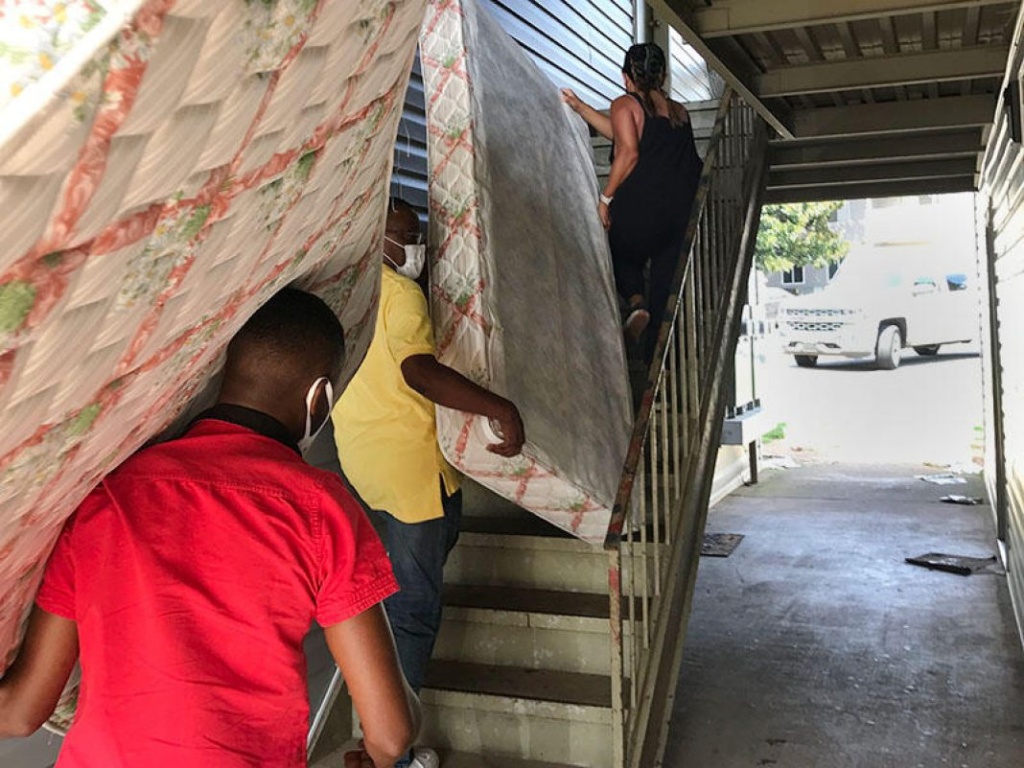Following the Taliban’s takeover of Afghanistan in August, thousands of Afghan people raced to the Karzai International Airport hoping to secure a spot on an airlift out of the country. The United States, along with allies and several private groups, evacuated more than 120,000 people from the airport by Aug. 30, 2021, the official date by which the U.S. was to leave Afghanistan.
- RELATED: Kentucky resettlement agency struggling to get housing for Afghan refugees
- RELATED: Afghan refugee arrivals in Bowling Green, Owensboro delayed
Since then, more 74,000 Afghans have arrived in the U.S., according to the U.S. State Department, and more are expected. But many refugees are finding it difficult to secure adequate housing in the face of expensive housing costs and a shortage of affordable units, which raises the questions: once a refugee steps off a plane, how does resettlement work? What cities do they go to? Who makes that decision? Where can refugees get help once they arrive in their new communities, and how does it all overlap with existing community development work?

Where do refugees live and how is the decision made?
The number of refugees admitted into the U.S. each year is set by the president and approved by Congress. President Joe Biden announced in February that he was increasing the number of refugees that were allowed to enter the U.S. to 125,000 after being criticized for slowly raising the cap from the historic low of 15,000 set by former President Donald Trump.
The State Department manages the U.S. Refugee Admissions Program, which requires involvement from multiple federal departments. For instance, the Department of Homeland Security oversees the vetting process, whereby refugees seeking resettlement undergo intense background checks and screenings. If a refugee passes this stage successfully and is approved for U.S. resettlement, they are then housed on U.S. military bases where they are processed and vaccinated. (As of Dec. 13, more than 38,000 Afghans have been relocated from military bases in the United States to their new communities.)
Each week the Department of State’s Reception and Placement Program and nine nonprofit refugee resettlement agencies review biographical information and the case records of each arriving Afghan family to determine where they will be resettled.
Personal connections in the U.S. are the most important factor in determining which community a refugee household is resettled in. Refugees who have friends or family in the states will be assigned to an agency that operates in that region. “If a refugee case does not have a U.S. tie, then they will get one assigned to one of the agencies based on the different characteristics of the case,” explains Chloe Shiras, the initial resettlement program manager at the Hebrew Immigrant Aid Society (HIAS). “For example, if there’s special health considerations, we’ll make sure they go to an office that has the capacity to take a case with significant health conditions. . . . Some offices have funding for medical case managers to provide additional support to cases who need that help. Other offices just have [regular] case management. They wouldn’t be able to provide that extra tailored support for medical cases who might need ongoing assistance past the initial resettlement period.”
In other words, different affiliate offices have different levels of capacity, staff, networks, and programming that meet (or do not meet) certain needs, all of which is factored into the decision of where to resettle someone.
While there are some exceptions, most refugees with family and friends in the U.S. are placed within 100 miles of a local affiliate’s office providing them with resettlement and placement services. Those without U.S. ties must be placed within 50 miles of and within the same state as their local affiliate. Regardless of where refugees are initially resettled, they are free to relocate at any time.
The Department of State’s Reception and Placement Program provides refugees with initial resettlement services for up to three months. This includes $2,275 per refugee resettled, with $1,225 of that money going toward food, shelter, and clothing, and $1,050 going to a local resettlement agency for administrative costs. Afghan refugees are also eligible for social services programs including Supplemental Nutritional Assistance Program (SNAP), Medicaid, Temporary Assistance for Needy Families (TANF), Supplemental Security Income, Head Start, Special Supplemental Nutrition Program for Women Infants and Children (WIC), and more.
The nonprofit refugee resettlement agencies help refugees access employment, health care, education, and other services via a large network of local offices in rural, urban, and suburban communities.
Afghan evacuees meet the American housing crisis
Finding housing for newly arrived refugees can be tough, says Shiras. “We’re seeing tons of issues with affordability and availability. At our offices in Seattle and the Bay Area, prices are just so high, and landlords are asking for three months of rent upfront.” In San Antonio, the issue is finding affordable housing that can accommodate large families. “We see a number of large families, like 6- to 11-member families,” says Elisa David-Kwanjai, the refugee resettlement program director at the Refugee Immigrant Center for Education and Legal Services (RAICES). “We need three- and four-bedroom units, which are extremely hard to find.”
Part of the difficulty in finding housing is due to the consequences of the past administration’s policies. “During the four years of the Trump administration, the resettlement program was really decimated. Having such a small number of refugee arrivals meant that a lot of those relationships with landlords got lost. Our resettlement agencies used to have a steady flow of arrivals coming in to fill up landlords’ apartments. And when that wasn’t happening, some of those connections got lost and landlords found other people to fill those units.”
For HIAS, private partnerships have been instrumental in securing short-term housing. Earlier this year, Airbnb pledged to house 20,000 Afghan evacuees worldwide. “For many of our clients, they will stay in an Airbnb for two to four weeks, before we’re able to find permanent housing for them. We also have partnerships with some hotels that provide us discounted rates. So Extended Stay, Hyatt, and Red Roof Inn provide all of our clients with discounted rates,” says Shiras. “But the U.S. government has actually been doing a lot of different initiatives to make housing more accessible for our clients. The Department of Homeland Security has been reaching out to private landlords and the State Department has created several different initiatives to help with this.”
Often the existing community can be a major housing resource. “I’d say currently, 100 percent [of Afghan evacuees in San Antonio served by RAICES] are living with relatives upon arrival, just because the turnaround is so quick,” says David-Kwanjai. “Arrivals are coming with extremely short notice, sometimes only 24 to 48 hours, so the best option for a resettlement agency is to see if they have family that is willing to house them, and if not, if friends or members of a local mosque are willing to house them.” HIAS is also leaning into local communities for support, kickstarting a program called Sponsor Circles that allows community members, like congregations, to sponsor Afghan evacuees during the initial resettlement process, helping to secure housing, provide necessities, and assist in accessing government benefits such as schooling, food, and health care.
Longer-term housing has been more of a challenge. Shiras says that much of the public and private focus has been in temporary housing because it is lower-hanging fruit. Longer-term resettlement assistance is provided by the Department of Health and Human Services’ Office of Refugee Resettlement, but this does not include rental assistance. For families who need longer-term housing support, local affiliates are often tasked with providing funds out of their own coffers.
HIAS has mainly worked to find long-term housing through private landlords due to the long wait times for subsidized housing. “Lists for Section 8 housing and things like that are just so long that it’s not really a viable, immediate solution. So [applying for] it may be something clients do for themselves later on after arrival, but it’s not looked [at] as a solution [for resettlement agencies],” Shiras explains. Additionally, the pandemic has pushed large numbers of people in big cities to move to smaller cities where many refugee communities are resettled, driving up the demand for housing and, in turn, the cost of housing.
Another major hurdle, according to David-Kwanjai, is that housing application processes can be quite difficult to navigate. Afghan refugees do not have a credit history and may lack identity documentation that housing complexes typically ask for. “We have to be able to establish relationships with those who understand that [refugees] may not have the documentation when they first arrive, but that usually within the first 30 days, they’ll have their Social Security card, [and other] documents, and that as a resettlement agency, we usually also assist with covering the first month’s rent,” David-Kwanjai says. “Depending on the size of the family and the benefits and services they’re eligible for, we may be able to help with covering the first few months of rent. I think once complexes understand that, they’re a little more willing to work with us, but I know that there are some management companies where they’re just like, ‘Sorry, that’s not our process. We need all of this upfront.’”
Shiras wants hesitant landlords to know that renting an apartment to a refugee means that they have an entire organization behind them to support the tenant with cultural orientation, the rental process, and providing rental payments those first couple of months. “There’s a lot more support there than it may seem when renting to refugee clients.”
Refugee resettlement agencies are also working against the clock with limited resources. “The Reception and Placement Program and the Afghan Placement and Assistance Program . . . last 90 days. So the goal of all of our resettlement agencies is to pay for rent for the first three to four months of arrival. That is very quick, but that is the reality of the refugee resettlement program,” says Shiras. “There’s a lot of pressure for clients to find jobs as soon as possible so that they can start to pay their rent. A big goal of the resettlement process is self-sufficiency very early on. Clients also are assisted in enrolling in cash assistance programs, [such as] TANF, or some other programs that they’re eligible for so they have that income coming in.” The supplemental funding that HIAS and other refugee resettlement agencies receive from their own fundraising efforts are therefore critical to meeting the needs of refugees. “So, for example, we received funding from the Latter-day Saints charities to provide housing support and emergency needs support for clients. We received that funding from Airbnb, so that $1,225 [federal stipend given to each refugee] doesn’t have to come from the clients’ money for temporary housing, we can save it for permanent housing. So we try to stretch it as much as we can,” Shiras explains.
Community development and refugee resettlement work often seem to happen on parallel tracks, but David-Kwanjai suggests that local governments and nonprofits interested in supporting resettlement efforts reach out to local resettlement agencies to understand the process and the exact needs in their community.
“We’ve gotten tons of generous offers to respond to the Afghanistan crisis and generous funding opportunities, but we’re also looking [at] refugee resettlement for the years to come where these emergency funds might not be available. We do really need to have affordable housing,” says Shiras.
Shiras also explains the need for more collaboration between resettlement agencies and housing groups. “This is now just a really intersectional part of our work . . . housing wasn’t always the biggest issue for resettlement. It now really is.”
Brandon Duong is an associate editor for Shelterforce. He received a master's degree from the Urban Planning & Policy program at the University of Illinois at Chicago.






